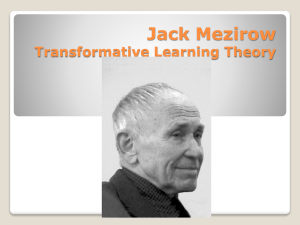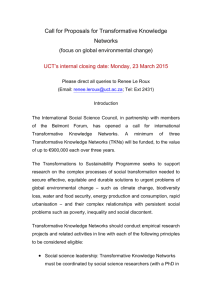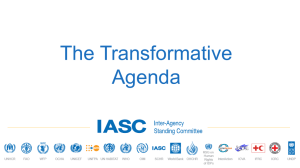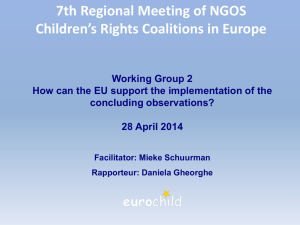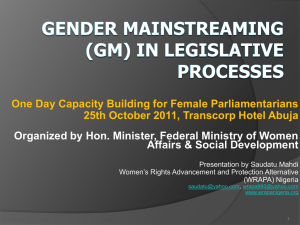Permalink
advertisement
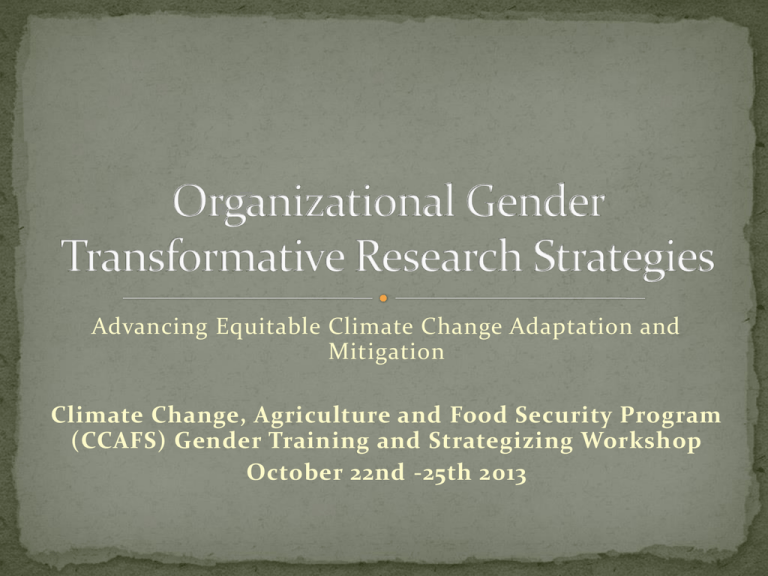
Advancing Equitable Climate Change Adaptation and Mitigation Climate Change, Agriculture and Food Security Program (CCAFS) Gender Training and Strategizing Workshop October 22nd -25th 2013 To explore the what, why and how of developing and/or strengthening organizational gender research strategies that support gender transformative approaches to tackling gender, climate change and food insecurity. Increased knowledge and understanding of: Key gender transformative concepts and approaches; What are the key elements to developing an effective, transformative organizational gender research strategy in climate change adaptation and mitigation; and How to facilitate and implement a process around building and implementing such a strategy that focuses on changing and challenging inequalities in organizations and in research programming and its impacts on supporting more equitable climate change adaptation and mitigation. An institutional commitment, master plan and road map for an organization and its staff and partners to mandate & articulate a commitment and define the what, why and how it will address gender and other social inequalities as central to or integrated into achieving its mission and vision; Should have internal operational and research program dimensions; May be integrated into a broader organizational gender research strategy or policy or may be stand alone. In either case it must be clearly linked to the organization's raisond’être. Should be an organisational and research program change process Such strategies are typically about how an organization will ensure gender mainstreaming – making gender issues central to all internal and program work from planning, implementing to M&E, learning and impact. Why GM; despite 15 years of unexpected results, GM still has the most transformative potential to address deeply rooted gender inequalities. Vision statement or goal and CC expertise worked in together. Approach (I.e. gender transformative) Justification M&E and learning system Objectives, strategies, activities and expected results with internal and research programming dimensions A conceptual framework or theory of change (optional) Guiding principles (optional) Detailed breakdown of approach and activities for internal and research program dimensions Partnerships Roles and responsibilities –i.e Gender Communications strategy (optional) Action Plan and gender targets and indicators of success for tracking progress – should be SMART Budget Annexes with suggested research tools (optional) Introduction o Vision statement – should be linked directly and be central to the organizational mission and vision o Justification and rationale – why gender is important to climate change, agriculture and food security agendas (I.e. CCAFS Gender Strategy, pp. 4-7 and see Box 1). o Goal (=vision) and objectives (best to have internal and research program dimensions) (E.g. CGIAR gender strategy) Approach: E.g. Gender and Development, gender mainstreaming or a gender and sustainable livelihoods approach. Typically, it is about gender mainstreaming. In this case, it is best to be twin-tracked and gender sensitive to gender transformative. Ex: World Fish gender strategy articulates from the beginning commitment to a twin-track gender transformative and innovative approach. Goal, Objectives, Interventions and Expected Results – An overview of the whole change process the strategy is supporting. For example: CCAFS Gender Strategy Impact Pathways Or Objectives and key research questions; i.e. in World Fish’s gender transformative research strategy it has objectives and research questions to guide gender related research. Its Impact Pathways (=results framework) is described in its M&E. Partnership strategy – with whom you will work to achieve the goal and objectives and how you will work together (See CCFAS GS Outcomes Pathway) Approach, methods and activities generally and then for each objective or research theme– Examples of approaches may be gender mainstreaming for gender equality and women’s empowerment or gender analysis. For example, CCFAS gender strategy proposes gender analysis as the approach using a range of methods and tools such as gender research to answer specific questions related to gender inequality in the face of CC adaptation and mitigation. Activities should consist of concrete interventions in existing organizational and programming arrangements to ensure internal gender capacity, skills, commitment and systems and gender sensitive or gender specific and transformative research projects and programming Ex: CCAFS refers to gender analysis, gender research , gender in the research cycle and specific “Theme-based research activities for integrating gender (See pages 15-22) Roles and responsibilities – important to have clearly outlined roles and responsibilities for all levels of the organization from junior to senior levels to ensure accountability for planning, implementing, M&E and human and financial resource allocation . M&E and learning system – consists of the proposed M&E system to track progress on meeting gender strategy goal and objectives. It should outline how progress towards meeting expected results will be measured such as through quantitative and qualitative gender sensitive indicators. Use of a theory of change or a results framework or what CGIAR uses, a impact pathways diagram is important to have a logical link between the pathway among objectives, activities, time, indicators of success and means of verification. Action Plan and gender targets and indicators of success for tracking progress with means of verification; budget and human resource allocation Budget - allocation of appropriate human and financial resources to support achievement of the gender strategy objectives Approach – gender aware to transformative Communications strategy – best practice emphasizes the need to have a strong communication strategy in place to ensure gender remains front and centre and learning and documentation is brought back into organizational gender practice and into research programming and impact. Such a strategy helps keep senior management, staff and partners excited and clear on what gender sensitive or specific research is about and why. Conceptual frameworks for measuring change = theory of change Example: CARE’s Women’s Empowerment Framework to Climate Change Adaptation and Mitigation What strikes you as the most important element(s) for a strategy to have meaning in your organization? What strikes you as less important? Is there any thing missing? Other questions or concerns? Preparing for your strategy development or review of it One example: In a high mountain community in Tajikistan, food security was an increasing challenge due to shifting seasons that were negatively impacting women’s kitchen gardens. In dialogue with local men and women, an INGO helped design a simple technology to adapt to the changes. Cold frames (small, greenhouses) were constructed to start vegetable seedlings earlier in the spring and extend the growing season into the fall. Project research found that there was increased household production, crop diversity and nutrition. The project also worked with women to promote food preservation so that surpluses could be safely stored for consumption during the winter. Commitment - at institutional and staff levels Leadership on gender Policies – is there a gender policy? Is there for gender and CC? Systems – i.e. for learning Staff capacity – skills and knowledge. Is there needed gender/CC expertise and accountability structures? Gender/CC training and tools Gender and recruitment – is there gender balance in staffing at all levels? Communications Practice – what actual happens in practice? Gender analysis of local, national and international context in which concerned research project/program is targeting. Is the analysis a gender and CC lens? Is gender analysis applied for all research projects and or programs? Gender integration into the research program cycle - To what extent in planning, design, implementation, M&E and learning? Gender sensitive monitoring and evaluation – is gender disaggregated data collected and used to inform research? Does research contribute to changes in women and girls’ empowerment and or to addressing gender and CC adaptive capacity differences and inequalities for gender equality and improved CC adaptation and mitigation? Are best practices considered? Gender integration into the issues into its research work? research program cycle To what extent is it integrated? Is gender integration mandated by your organization for all research projects and programs? Are gender equality and CC goals and objectives included in program planning and design? Are women and men consulted equally using participatory methods from program design to M&E? Does your organization use best practices for integrating gender and CC Does your research programs/projects address gender disadvantages, roles and responsibilities and in terms of the different social relations women and men have? Does your research change or challenge unequal gender norms and practices influencing CC adaptation and mitigation? Do they address the most vulnerable and disadvantaged needs and interests? Gender sensitive monitoring and evaluation Is gender disaggregated data collected? Is the gender disaggregated data used to improve and adjust research programming? Does your organization's research contribute to women and girls’ empowerment? Does it contribute to changing or challenging unequal gender and unequal social relations for more equitable CC adaptation and mitigation? For example – understanding gender differences in what kinds of climate-smart technologies would be best suited for women and or men and contribute to gender equality and CC agendas. Gender Audits – Examples are: InterAction’s Gender Audit & ILO Participatory Gender Audit Gender and diversity assessments – less easy to find but can use various tools together. Lighter gender assessment tools – SWOT analysis or light gender audit from InterAction’s Gender Audit. Consider combining CC/environmental assessment tools with gender specific questions adapted/adapted from gender audit tools. What are the lessons learned to draw from? Step 1: Preparation phase First you need to know if your organization is ready for it. Carrying out a light gender scan of where your organization is at in advancing a gender and climate change agenda is a good practice. You may have to first ensure some human and financial resources are available or that your leadership is committed to making gender and CC a strategic priority. Gain buy in and leadership from senior management to lead the strategy development and or review. Leadership should clearly communicate to all staff that this strategy is a priority. Set up or strengthen cross-organizational gender and CC working group with senior management representation (bring together the gender and CC experts) to lead on the process As much as possible, create open “thinking outside the box” facilitated discussions among all staff and in smaller teams on what gender and CC means in internal operations and in research programming. This builds political will, ownership, accountability and staff enthusiasm and skill in gender and CC. Consult with your allies inside and outside the organization to understand where your organization is in the gender mainstreaming process and in its commitment to gender and CC. Consider conducting a gender and or gender and diversity audit with CC issues integrated into assessment questions. The audit provides the roadmap for developing a strategy. The process itself of developing a strategy is as much an opportunity to build staff knowledge, skill and know-how on gender and CC as the final document. •Step 2: Design and develop strategy •Use audit results and recommendations •Work with cross-organizational gender and CC working group to review audit results and priorities of organization •Senior leadership should clearly communicate importance of strategy development or review and that all staff must give time to the process •Conduct a consultative process with all staff to design the strategy Consider hiring an external gender and CC expert as facilitator and coach but working closely with the gender and CC working group Review best practices and most appropriate approaches, tools and methodologies. Consult with different members of your research teams and organization. Conduct a validation workshop for all staff and partners to review the strategy document and action plan on priorities with time frame, roles and responsibilities and gender targets and means of verification Senior management endorses it and communicates its importance Step 3: Follow up Regular M and E and learning Gender reviews every 2-3 years Need to create learning spaces for staff at all levels to build ownership and to understand for themselves their commitment to gender and CC; Cross-organizational group with senior management representation should be in place from the preparation phase Design a strategy that is integrated into everyday work and bigger events Process means everything – it is about facilitating an organizational, staff and personal change process Take a twin-track gender mainstreaming approach; if possible consider making it a transformative agenda. (I.e. World Fish) Bring in strong external facilitator to lead discussions and influence thinking and drawing from internal experts and gender champions, esp. from leadership The strategy should be informed by what is working and not working in your organization’s work on gender and climate change Create a participatory consultative process to engage staff, research subjects, partners and other external allies in defining the key issues Build strategy based on what has worked and be innovative; think outside the box “You are writing a terms of reference (TOR) to present to your senior management for designing your organizational gender research strategy or a review of it, what do you think are the most critical steps and criteria for the success of the process from the beginning to the follow-up stage?” Briefly discuss where your organization is at in gender mainstreaming gender and CC into its work? Try to bring together some key points based on a mix of your various organizations (10 min) What are the critical steps you will take from the preparation phase to follow up? (10 min) What will be your main approaches and research methods? (i.e. gender mainstreaming, gender analysis etc.)? (15 min) What will be the key elements in your strategy? (20 min)


